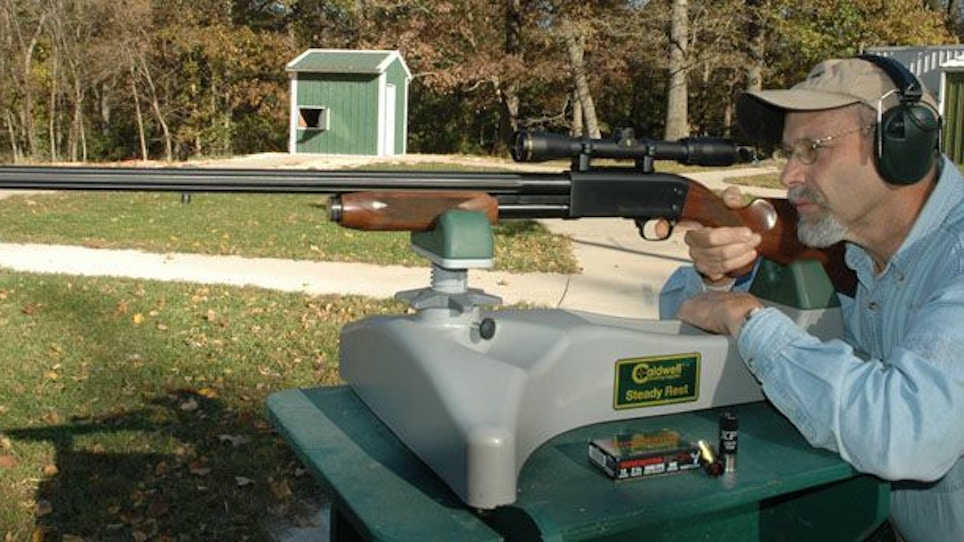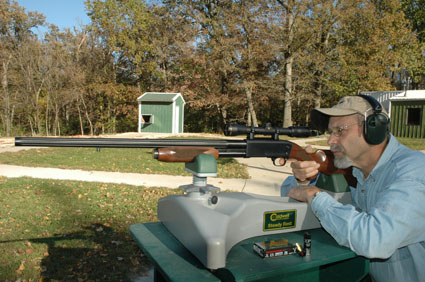 Now here’s a statement we hunters, or at least those of us having long celebrated our 40-year birthday, will find quite elemental — outdoor equipment has come a long way. Scent elimination suits are as common as old-school two-slice toasters. So, too, are digital trail cameras that wirelessly transmit images to a hunter’s PDA — that’s personal data assistant, if you happen to be technologically challenged such as I am.
Now here’s a statement we hunters, or at least those of us having long celebrated our 40-year birthday, will find quite elemental — outdoor equipment has come a long way. Scent elimination suits are as common as old-school two-slice toasters. So, too, are digital trail cameras that wirelessly transmit images to a hunter’s PDA — that’s personal data assistant, if you happen to be technologically challenged such as I am.
Not to be left behind are the dedicated whitetail shotguns. My first Ohio deer fell to a Foster-style Remington Slugger rifled slug at a distance of 25 steps. The firearm? A plain-Jane M1100 autoloader 16-gauge. The barrel was smooth, as shotgun barrels were back in the day, and her optics consisted of a single silver front bead. Accuracy with the old girl was everything on a 9-inch paper plate, with the forearm rested, at 50 yards. Minute-of-angle? I don’t think so.
Fast-forward into the 21st century. We had earlier swapped our smoothbore M1100 barrels for fully-rifled tubes outfitted with adjustable iron sights. The open sights quickly gave way to B-Square saddle mounts, and 1-inch fixed four-powers. The ammunition we fed the guns changed radically, too. Round-nosed Foster slugs were relegated to the shelves, replaced by the new sabotted projectiles designed specifically for these cutting-edge rifled barrels. Accuracy improved dramatically; likewise our confidence in our ability to consistently drop these high-tech slugs into something the size of a baseball at 100 yards, if not a little more. All was right in the slug-shooter’s world, save, perhaps, for the fact these ultra-modern shotguns, though undeniably effective, little resembled the guns of our fathers.
Thankfully, there’s an answer for those wondering if traditional looks must be sacrificed in order to achieve Year 2011 performance from a slug gun. The answer, as evidenced by Ithaca’s Model 37 Deerslayer III, is a resounding no.
Technically Speaking
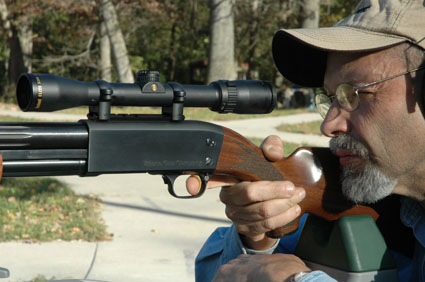 Even if you’re never owned one, there’s a good chance you’re familiar with Ithaca’s classic Model 37 pump-gun. What you might not be familiar with is the history behind the gun, which began life as the Remington M17, and which itself would eventually morph into one of the most recognized pump-guns of all-time, the Remington M870. However, with the expiration of the original patents for Remington’s M17 in 1937, the Ithaca Gun Company, tooled and waiting for the new piece since 1933, began producing what’s now known as the venerable M37.
Even if you’re never owned one, there’s a good chance you’re familiar with Ithaca’s classic Model 37 pump-gun. What you might not be familiar with is the history behind the gun, which began life as the Remington M17, and which itself would eventually morph into one of the most recognized pump-guns of all-time, the Remington M870. However, with the expiration of the original patents for Remington’s M17 in 1937, the Ithaca Gun Company, tooled and waiting for the new piece since 1933, began producing what’s now known as the venerable M37.
Venerable, she is; reliable, too. And many would say the M37 is the essence of traditional field shotgun styling — slim and light, yet rugged, dependable and low-maintenance, a trait due in part to the gun’s bottom loading and ejection port. Even the Deerslayer III, with her heavy fluted barrel, drilled receiver and high Monte Carlo stock, displays all the tradition, class and elegance you would expect from a 73-year-old shotgun.
But for all her high-tech achievements on the range and in the field — NOTE: Ithaca claims 4-inch three-shot groups at 200 yards — the M37 Deerslayer III remains almost as basic as the original. The receiver is still machined from a single block of steel; the slide release remains set at the front right edge of the trigger guard, with the simple lightly checkered crossbolt safety at the rear. The M37’s bottom ejection makes the shotgun ambidextrous; however, southpaws will need to replace the original right-hand safety with a left hand-specific piece, if they so choose. Both the pistol grip and forearm are checkered — nothing special nor exceptionally attractive, but efficient.
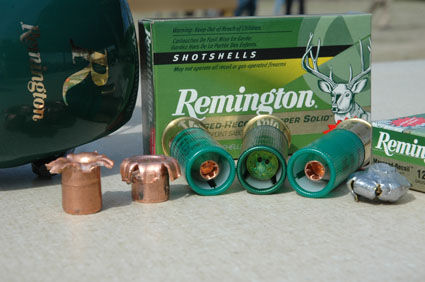 Basic, she is; however, the folks in Upper Sanduskry, Ohio, have made several improvements to the traditional M37 design in coming up with the Deerslayer III, most, if not all of which reflect directly upon the new shotgun’s role as a slayer of deer. Introduced in 1959, the original Deerslayer wasn’t much far removed from the shot-slinging M37, save for the addition of iron sights, a non-interchangeable cylinder choke, and a better barrel-to-receiver fit. Twenty-nine years later, a fully rifled barrel was offered. In 1996, the Deerslayer II was introduced, this model featuring a barrel both threaded into the receiver, and free-floated; advancements meant to push the centerfire rifle envelope in terms of accuracy out of a production-grade and comparatively inexpensive shotgun. In a subsequent progression, a heavy (bull) fluted barrel was threaded onto the DSII’s sturdy steel receiver, and a third ‘I’ added, thus presenting Eastern whitetail fanatics with the ultimate in long-range deer weaponry — the Deerslayer III.
Basic, she is; however, the folks in Upper Sanduskry, Ohio, have made several improvements to the traditional M37 design in coming up with the Deerslayer III, most, if not all of which reflect directly upon the new shotgun’s role as a slayer of deer. Introduced in 1959, the original Deerslayer wasn’t much far removed from the shot-slinging M37, save for the addition of iron sights, a non-interchangeable cylinder choke, and a better barrel-to-receiver fit. Twenty-nine years later, a fully rifled barrel was offered. In 1996, the Deerslayer II was introduced, this model featuring a barrel both threaded into the receiver, and free-floated; advancements meant to push the centerfire rifle envelope in terms of accuracy out of a production-grade and comparatively inexpensive shotgun. In a subsequent progression, a heavy (bull) fluted barrel was threaded onto the DSII’s sturdy steel receiver, and a third ‘I’ added, thus presenting Eastern whitetail fanatics with the ultimate in long-range deer weaponry — the Deerslayer III.
My Personal Report Card
The guest of fellow writer and sportsman Phil Bourjaily, I spent a wonderful weekday afternoon at a small gun club outside of Iowa City, Iowa, shooting a potpourri of firearms, one of which was Bourjaily’s pet Deerslayer III. “For a slug gun,” Bourjaily 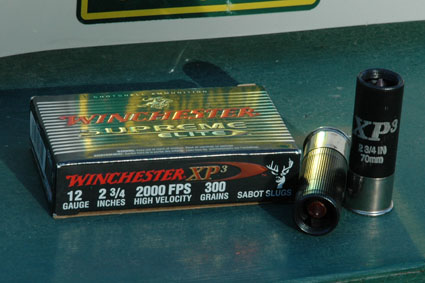 told me, “this one has a good trigger right out of the box. It’s heavy, no question, but it has a good feel to it.” Although more of an experiment than an actual “for the record” test of accuracy, the DSIII, that afternoon filled with Winchester’s XP3 sabotted slugs (2 ¾-inch, 2000 feet/second, 300 grains) did quite well at 50 yards, which on this predominantly trap/skeet-focused field was the greatest distance we were offered. And by well here, I’m speaking of a three-shot group roughly the size of a silver dollar about an inch high which, at least according to the company’s on-line trajectory tables, should put the big slug right on the 10-spot at 100 steps. “I sighted the gun in with Remington’s Copper Solids,” Bourjaily said. “At 50 yards, every shot was touching the one before it.”
told me, “this one has a good trigger right out of the box. It’s heavy, no question, but it has a good feel to it.” Although more of an experiment than an actual “for the record” test of accuracy, the DSIII, that afternoon filled with Winchester’s XP3 sabotted slugs (2 ¾-inch, 2000 feet/second, 300 grains) did quite well at 50 yards, which on this predominantly trap/skeet-focused field was the greatest distance we were offered. And by well here, I’m speaking of a three-shot group roughly the size of a silver dollar about an inch high which, at least according to the company’s on-line trajectory tables, should put the big slug right on the 10-spot at 100 steps. “I sighted the gun in with Remington’s Copper Solids,” Bourjaily said. “At 50 yards, every shot was touching the one before it.”
From stem to stern, I like Ithaca’s latest dedicated whitetail shotgun. By my own admission, I’m not much of a ‘bottom eject’ man, a personality trait largely the result of toting shotguns which either break open or regurgitate empties via the right hand side of the receiver; however, for those accustomed to such an operating system — and there are many of you — you, by your own admission, wouldn’t have it any other way. Bourjaily’s personal DSIII cycled smoothly, with a very definite release and an equally sure lockup on the forward stroke. It is, at more than 10 pounds including optics and three rounds, a heavy piece; one which I wouldn’t relish carrying day after day in a role as rouster on a series of Midwestern deer drives. But, this heft has a reason, and for those taken to elevated stands or ground blinds, the additional weight shouldn’t prove problematic — and actually should be a virtue when that 174-inch buck of a lifetime steps into the edge at 127 laser-ranged paces.
